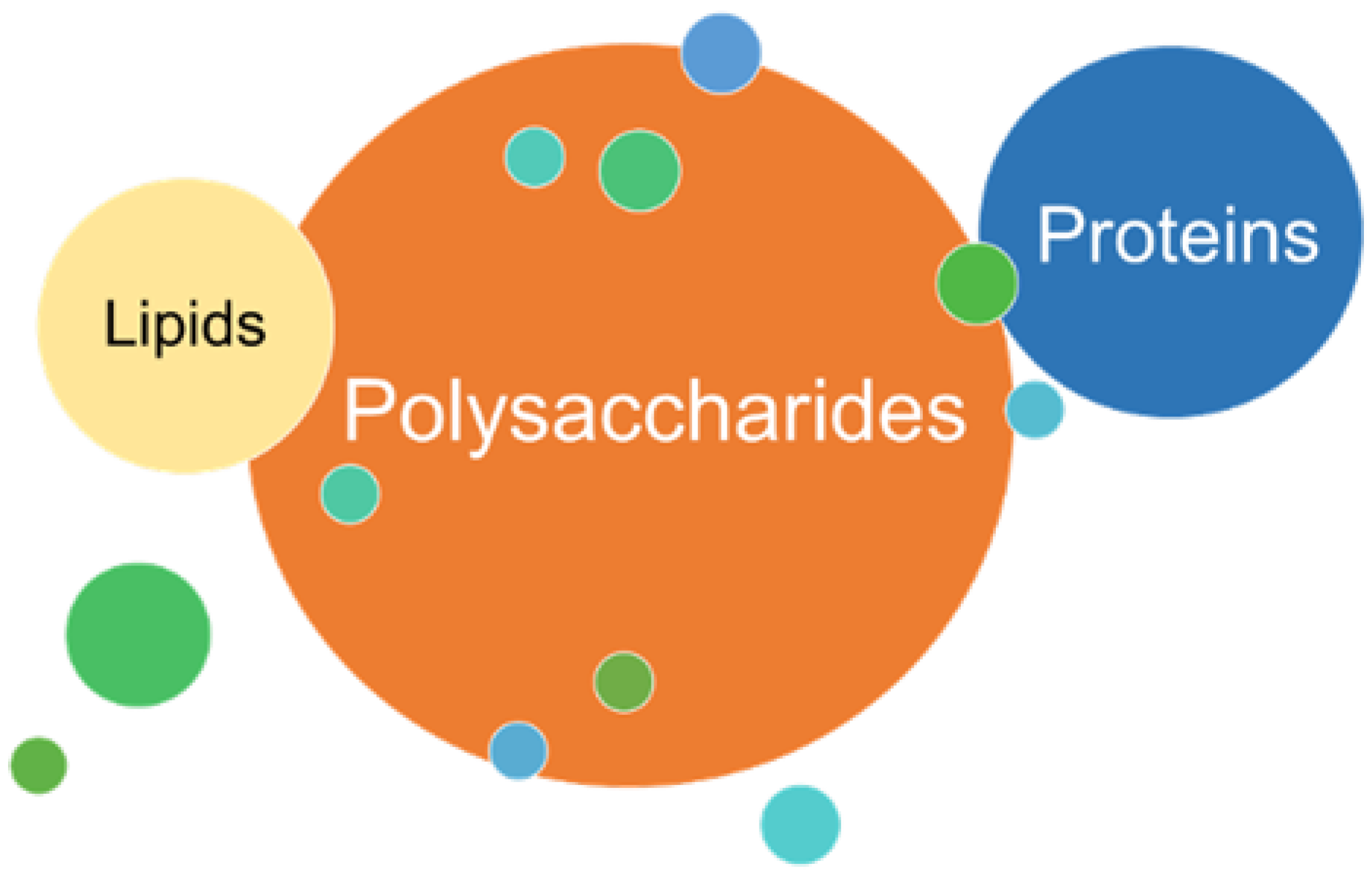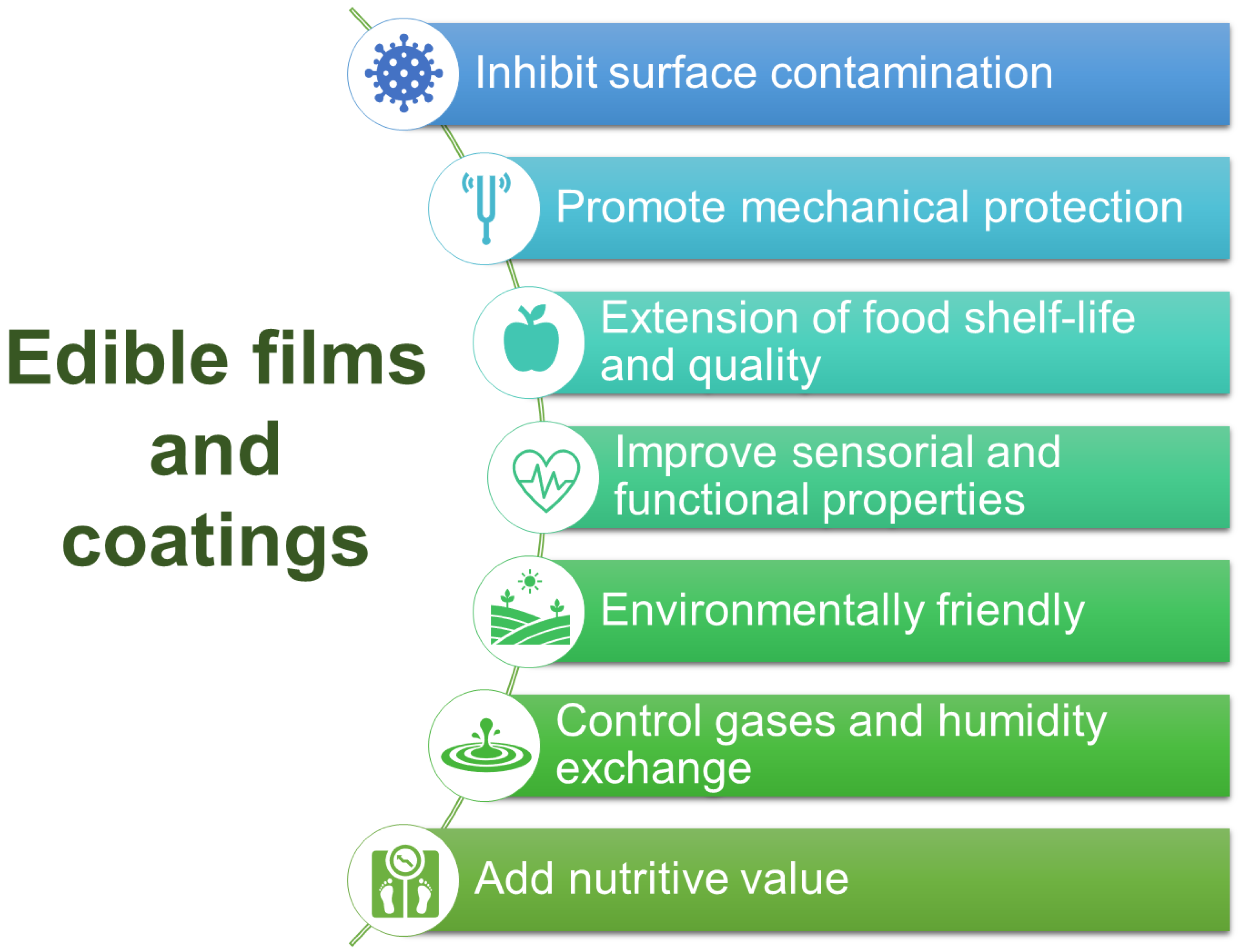Natural polymers like polysaccharides and proteins, i.e., alginate; carrageenan; chitosan; starch; pea protein, are important materials obtained from renewable plant, algae and animal sources, as well as from agroindustrial residues. Historically, some of them have been widely used by ancient populations for food packaging until these were replaced by petroleum-based plastic materials after World War II. Nowadays, biobased materials for food packaging have attracted attention. Their use was boosted especially because of the environmental pollution caused by inappropriate disposal of plastic packaging. Biobased materials are welcome to the design of food packaging because they possess many advantages, such as biodegradability, biocompatibility and low toxicity. Depending on the formulation, certain biopolymer-based packaging may present good barrier properties, antimicrobial and antioxidant activities Thus, polysaccharides and proteins can be combined to form diverse composite films with improved mechanical and biological behaviors, making them suitable for packaging of different food products.
- food packaging
- biobased materials
- biodegradable packaging
- edible films
- composite films
- alginate
- carrageenan
- chitosan
- starch
- pea protein
1. Introduction
2. Some Natural and Renewable Macromolecules Used to Prepare Edible Films and Coatings


| Biomacromolecules | Raw Materials | References |
|---|---|---|
| Polysaccharides | Agar | [17] |
| Alginate | [18] | |
| Cellulose | [19] | |
| Chitosan | [20] | |
| Gums | [21] | |
| K-carrageenan | [22][23] | |
| Pectin | [24] | |
| Pullulan | [25] | |
| Starch | [26][27] | |
| Proteins | Casein | [28] |
| Collagen | [29] | |
| Corn zein | [30] | |
| Gelatin | [19] | |
| Pea protein | [31] | |
| Sodium caseinate | [24] | |
| Soy protein | [32] | |
| Wheat gluten | [33] | |
| Whey protein | [34] | |
| Lipids | Candelilla wax | [35] |
| Bee wax | [36] | |
| Vegetable oils | [37] | |
| Composites | Blends | [5][25][28][29][34] |
| Residues and by-products from agriculture | [38][39][40] | |
| Fruit pulps | [41] |
| Matrix | Concentration | Additives | Food Product | Reference |
|---|---|---|---|---|
| Carboxymethyl chitosan/pullulan | Different mixing ratio of 5:0, 4:1, 3:2, 2.5:2.5, 2:3 and 1:4 (w/w) | 8% galangal essential oil and 20% glycerol (w/w) | Mangoes | [25] |
| Chitosan | 1% (w/v) | 40 mmol L−1 of ascorbic acid | Plums (Prunus salicina) | [43] |
| Κ-carrageenan | 0.2–0.8% (w/v) | 0–1% glycerol (w/v) | Papaya (Carica papaya) | [22] |
| Sodium alginate | 0, 1 and 3% (w/v) | 20% glycerol (v/v) | Plum (Prunus salicina) | [44] |
| Sodium alginate | 1.5% (w/v) | Ficus hirta extract, 0.7% citric acid and 1.0% sucrose ester (w/v) | Nanfeng mandarin (Citrus reticulata) | [45] |
| Starch/chitosan | 2%/0.5–1.0% (w/v) | 2% glycerol (w/v) | Apples Fuji cultivar | [27] |
| Starch/gelatin | 3–5%/10% (1:1) | 10% sorbitol | Red Crimson grapes | [46] |
| Xantham gum | 2.5 g L−1 | 1.0 g L−1 cinnamic acid | Pears (Pyrus pyrifolia and P. communis) | [21] |
3. Conclusions
This entry is adapted from the peer-reviewed paper 10.3390/polysaccharides3010002
References
- Verma, M.K.; Shakya, S.; Kumar, P.; Madhavi, J.; Murugaiyan, J.; Rao, M.V.R. Trends in Packaging Material for Food Products: Historical Background, Current Scenario, and Future Prospects. J. Food Sci. Technol. 2021, 58, 4069–4082.
- Brody, A.L.; Bugusu, B.; Han, J.H.; Sand, C.K.; McHugh, T.H. Innovative Food Packaging Solutions. J. Food Sci. 2008, 73, 107–116.
- Page, B. Rigid Metal Packaging. In Packaging Technology; Emblem, A., Emblem, H., Eds.; Elsevier: Amsterdam, The Netherlands, 2012; pp. 122–162.
- Jia, L.; Evans, S.; van der Linden, S. Motivating Actions to Mitigate Plastic Pollution. Nat. Commun. 2019, 10, 4582.
- Kamdem, D.P.; Shen, Z.; Nabinejad, O. Development of Biodegradable Composite Chitosan-Based Films Incorporated with Xylan and Carvacrol for Food Packaging Application. Food Packag. Shelf Life 2019, 21, 100344.
- Carina, D.; Sharma, S.; Jaiswal, A.K.; Jaiswal, S. Seaweeds Polysaccharides in Active Food Packaging: A Review of Recent Progress. Trends Food Sci. Technol. 2021, 110, 559–572.
- Mohamed, S.A.A.; El-Sakhawy, M.; El-Sakhawy, M.A.-M. Polysaccharides, Protein and Lipid -Based Natural Edible Films in Food Packaging: A Review. Carbohydr. Polym. 2020, 238, 116178.
- Petkoska, A.T.; Daniloski, D.; D’Cunha, N.M.; Naumovski, N.; Broach, A.T. Edible Packaging: Sustainable Solutions and Novel Trends in Food Packaging. Food Res. Int. 2021, 140, 109981.
- Cazón, P.; Velazquez, G.; Ramírez, J.A.; Vázquez, M. Polysaccharide-Based Films and Coatings for Food Packaging: A Review. Food Hydrocoll. 2017, 68, 136–148.
- Liang, J.; Yan, H.; Zhang, J.; Dai, W.; Gao, X.; Zhou, Y.; Wan, X.; Puligundla, P. Preparation and Characterization of Antioxidant Edible Chitosan Films Incorporated with Epigallocatechin Gallate Nanocapsules. Carbohydr. Polym. 2017, 171, 300–306.
- Quirós-Sauceda, A.E.; Ayala-Zavala, J.F.; Olivas, G.I.; González-Aguilar, G.A. Edible Coatings as Encapsulating Matrices for Bioactive Compounds: A Review. J. Food Sci. Technol. 2014, 51, 1674–1685.
- Burger, T.G.; Zhang, Y. Recent Progress in the Utilization of Pea Protein as an Emulsifier for Food Applications. Trends Food Sci. Technol. 2019, 86, 25–33.
- Assad, I.; Bhat, S.U.; Gani, A.; Shah, A. Protein Based Packaging of Plant Origin: Fabrication, Properties, Recent Advances and Future Perspectives. Int. J. Biol. Macromol. 2020, 164, 707–716.
- Silva-Weiss, A.; Ihl, M.; Sobral, P.J.A.; Gómez-Guillén, M.C.; Bifani, V. Natural Additives in Bioactive Edible Films and Coatings: Functionality and Applications in Foods. Food Eng. Rev. 2013, 5, 200–216.
- Otoni, C.G.; Avena-Bustillos, R.J.; Azeredo, H.M.C.; Lorevice, M.V.; Moura, M.R.; Mattoso, L.H.C.; McHugh, T.H. Recent Advances on Edible Films Based on Fruits and Vegetables-A Review. Compr. Rev. Food Sci. Food Saf. 2017, 16, 1151–1169.
- Mkandawire, M.; Aryee, A.N. Resurfacing and Modernization of Edible Packaging Material Technology. Curr. Opin. Food Sci. 2018, 19, 104–112.
- Sousa, A.M.M.; Souza, H.K.S.; Latona, N.; Liu, C.K.; Gonçalves, M.P.; Liu, L. Choline Chloride Based Ionic Liquid Analogues as Tool for the Fabrication of Agar Films with Improved Mechanical Properties. Carbohydr. Polym. 2014, 111, 206–214.
- Vital, A.C.P.; Guerrero, A.; Ornaghi, M.G.; Kempinski, E.M.B.C.; Sary, C.; Monteschio, J.O.; Matumoto-Pintro, P.T.; Ribeiro, R.P.; do Prado, I.N. Quality and Sensory Acceptability of Fish Fillet (Oreochromis Niloticus) with Alginate-Based Coating Containing Essential Oils. J. Food Sci. Technol. 2018, 55, 4945–4955.
- Kowalczyk, D.; Szymanowska, U.; Skrzypek, T.; Basiura-Cembala, M.; Łupina, K.; Biendl, M. Edible Films Based on Gelatin, Carboxymethyl Cellulose, and Their Blends as Carriers of Potassium Salts of Iso-α-Acids: Structural, Physicochemical and Antioxidant Properties. Food Hydrocoll. 2021, 115, 106574.
- Mujtaba, M.; Morsi, R.E.; Kerch, G.; Elsabee, M.Z.; Kaya, M.; Labidi, J.; Khawar, K.M. Current Advancements in Chitosan-Based Film Production for Food Technology; A Review. Int. J. Biol. Macromol. 2019, 121, 889–904.
- Sharma, S.; Rao, T.V.R. Xanthan Gum Based Edible Coating Enriched with Cinnamic Acid Prevents Browning and Extends the Shelf-Life of Fresh-Cut Pears. LWT-Food Sci. Technol. 2015, 62, 791–800.
- Hamzah, H.M.; Osman, A.; Tan, C.P.; Mohamad Ghazali, F. Carrageenan as an Alternative Coating for Papaya (Carica Papaya L. Cv. Eksotika). Postharvest Biol. Technol. 2013, 75, 142–146.
- Tran, T.T.B.; Roach, P.; Nguyen, M.H.; Pristijono, P.; Vuong, Q.V. Development of Biodegradable Films Based on Seaweed Polysaccharides and Gac Pulp (Momordica Cochinchinensis), the Waste Generated from Gac Oil Production. Food Hydrocoll. 2020, 99, 105322.
- Jahromi, M.; Niakousari, M.; Golmakani, M.T.; Mohammadifar, M.A. Physicochemical and Structural Characterization of Sodium Caseinate Based Film-Forming Solutions and Edible Films as Affected by High Methoxyl Pectin. Int. J. Biol. Macromol. 2020, 165, 1949–1959.
- Zhou, W.; He, Y.; Liu, F.; Liao, L.; Huang, X.; Li, R.; Zou, Y.; Zhou, L.; Zou, L.; Liu, Y.; et al. Carboxymethyl Chitosan-Pullulan Edible Films Enriched with Galangal Essential Oil: Characterization and Application in Mango Preservation. Carbohydr. Polym. 2021, 256, 117579.
- Moreno, O.; Atarés, L.; Chiralt, A. Effect of the Incorporation of Antimicrobial/Antioxidant Proteins on the Properties of Potato Starch Films. Carbohydr. Polym. 2015, 133, 353–364.
- Costa, J.C.M.; Miki, K.S.L.; da Silva Ramos, A.; Teixeira-Costa, B.E. Development of Biodegradable Films Based on Purple Yam Starch/Chitosan for Food Application. Heliyon 2020, 6, 1–10.
- Chevalier, E.; Chaabani, A.; Assezat, G.; Prochazka, F.; Oulahal, N. Casein/Wax Blend Extrusion for Production of Edible Films as Carriers of Potassium Sorbate—A Comparative Study of Waxes and Potassium Sorbate Effect. Food Packag. Shelf Life 2018, 16, 41–50.
- Jiang, Y.; Lan, W.; Sameen, D.E.; Ahmed, S.; Qin, W.; Zhang, Q.; Chen, H.; Dai, J.; He, L.; Liu, Y. Preparation and Characterization of Grass Carp Collagen-Chitosan-Lemon Essential Oil Composite Films for Application as Food Packaging. Int. J. Biol. Macromol. 2020, 160, 340–351.
- Sun, Y.; Liu, Z.; Zhang, L.; Wang, X.; Li, L. Effects of Plasticizer Type and Concentration on Rheological, Physico-Mechanical and Structural Properties of Chitosan/Zein Film. Int. J. Biol. Macromol. 2020, 143, 334–340.
- Acquah, C.; Zhang, Y.; Dubé, M.A.; Udenigwe, C.C. Formation and Characterization of Protein-Based Films from Yellow Pea (Pisum Sativum) Protein Isolate and Concentrate for Edible Applications. Curr. Res. Food Sci. 2020, 2, 61–69.
- Maryam Adilah, Z.A.; Jamilah, B.; Nur Hanani, Z.A. Functional and Antioxidant Properties of Protein-Based Films Incorporated with Mango Kernel Extract for Active Packaging. Food Hydrocoll. 2018, 74, 207–218.
- Ansorena, M.R.; Zubeldía, F.; Marcovich, N.E. Active Wheat Gluten Films Obtained by Thermoplastic Processing. LWT-Food Sci. Technol. 2016, 69, 47–54.
- Azevedo, V.M.; Borges, S.V.; Marconcini, J.M.; Yoshida, M.I.; Neto, A.R.S.; Pereira, T.C.; Pereira, C.F.G. Effect of Replacement of Corn Starch by Whey Protein Isolate in Biodegradable Film Blends Obtained by Extrusion. Carbohydr. Polym. 2017, 157, 971–980.
- De León-Zapata, M.A.; Sáenz-Galindo, A.; Rojas-Molina, R.; Rodríguez-Herrera, R.; Jasso-Cantú, D.; Aguilar, C.N. Edible Candelilla Wax Coating with Fermented Extract of Tarbush Improves the Shelf Life and Quality of Apples. Food Packag. Shelf Life 2015, 3, 70–75.
- Rocca-Smith, J.R.; Marcuzzo, E.; Karbowiak, T.; Centa, J.; Giacometti, M.; Scapin, F.; Venir, E.; Sensidoni, A.; Debeaufort, F. Effect of Lipid Incorporation on Functional Properties of Wheat Gluten Based Edible Films. J. Cereal Sci. 2016, 69, 275–282.
- Rodrigues, D.C.; Cunha, A.P.; Brito, E.S.; Azeredo, H.M.C.; Gallão, M.I. Mesquite Seed Gum and Palm Fruit Oil Emulsion Edible Films: Influence of Oil Content and Sonication. Food Hydrocoll. 2016, 56, 227–235.
- Garrido, T.; Etxabide, A.; Leceta, I.; Cabezudo, S.; de la Caba, K.; Guerrero, P. Valorization of Soya By-Products for Sustainable Packaging. J. Clean. Prod. 2014, 64, 228–233.
- Ferreira, M.S.L.; Fai, A.E.C.; Andrade, C.T.; Picciani, P.H.; Azero, E.G.; Gonçalves, É.C.B.A. Edible Films and Coatings Based on Biodegradable Residues Applied to Acerolas (Malpighia punicifolia L.). J. Sci. Food Agric. 2016, 96, 1634–1642.
- Munhoz, D.R.; Moreira, F.K.V.; Bresolin, J.D.; Bernardo, M.P.; De Sousa, C.P.; Mattoso, L.H.C. Sustainable Production and in Vitro Biodegradability of Edible Films from Yellow Passion Fruit Coproducts via Continuous Casting. ACS Sustain. Chem. Eng. 2018, 6, 9883–9892.
- Espitia, P.J.P.; Avena-Bustillos, R.J.; Du, W.-X.; Teófilo, R.F.; Soares, N.F.F.; McHugh, T.H. Optimal Antimicrobial Formulation and Physical–Mechanical Properties of Edible Films Based on Açaí and Pectin for Food Preservation. Food Packag. Shelf Life 2014, 2, 38–49.
- Tavassoli-Kafrani, E.; Shekarchizadeh, H.; Masoudpour-Behabadi, M. Development of Edible Films and Coatings from Alginates and Carrageenans. Carbohydr. Polym. 2016, 137, 360–374.
- Liu, K.; Yuan, C.; Chen, Y.; Li, H.; Liu, J. Combined Effects of Ascorbic Acid and Chitosan on the Quality Maintenance and Shelf Life of Plums. Sci. Hortic. Amst. 2014, 176, 45–53.
- Valero, D.; Díaz-Mula, H.M.; Zapata, P.J.; Guillén, F.; Martínez-Romero, D.; Castillo, S.; Serrano, M. Effects of Alginate Edible Coating on Preserving Fruit Quality in Four Plum Cultivars during Postharvest Storage. Postharvest. Biol. Technol. 2013, 77, 1–6.
- Chen, C.; Peng, X.; Zeng, R.; Chen, M.; Wan, C.; Chen, J. Ficus Hirta Fruits Extract Incorporated into an Alginate-Based Edible Coating for Nanfeng Mandarin Preservation. Sci. Hortic. Amst. 2016, 202, 41–48.
- Fakhouri, F.M.; Martelli, S.M.; Caon, T.; Velasco, J.I.; Mei, L.H.I. Edible Films and Coatings Based on Starch/Gelatin: Film Properties and Effect of Coatings on Quality of Refrigerated Red Crimson Grapes. Postharvest. Biol. Technol. 2015, 109, 57–64.
